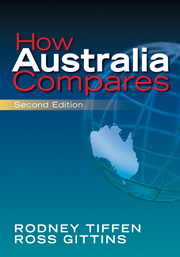Book contents
- Frontmatter
- Contents
- List of tables and figures
- Preface to the second edition
- Acknowledgements
- Reading the tables
- Abbreviations
- Introduction
- 1 People
- 2 Government and politics
- 3 Economics
- 4 Work and labour
- 5 Government taxes and spending
- 6 Health
- 7 Education
- 8 Inequality and social welfare
- 9 International relations
- 10 Environment
- 11 Science and technology
- 12 Telecommunications and computing
- 13 Media
- 14 Family
- 15 Lifestyles and consumption
- 16 Crime and social problems
- 17 The search for scoreboards
- 18 The Howard impact
- Sources and references
6 - Health
Published online by Cambridge University Press: 05 June 2012
- Frontmatter
- Contents
- List of tables and figures
- Preface to the second edition
- Acknowledgements
- Reading the tables
- Abbreviations
- Introduction
- 1 People
- 2 Government and politics
- 3 Economics
- 4 Work and labour
- 5 Government taxes and spending
- 6 Health
- 7 Education
- 8 Inequality and social welfare
- 9 International relations
- 10 Environment
- 11 Science and technology
- 12 Telecommunications and computing
- 13 Media
- 14 Family
- 15 Lifestyles and consumption
- 16 Crime and social problems
- 17 The search for scoreboards
- 18 The Howard impact
- Sources and references
Summary
Total health spending
If you wonder why arguments about the funding of health care are rarely out of the news, Table 6.1 offers a big clue. Spending on health – by governments, private organisations and individuals – has grown rapidly and relentlessly in recent decades. Table 6.1 shows how, expressed as a proportion of national income (GDP), health spending more than doubled in the selected countries over the last 40 years of the 20th century, and kept on climbing in the first years of the 21st century.
It should be remembered that when spending on any item rises over time as a proportion of GDP, this means it is growing at a faster real rate than the overall economy. Thus the increases revealed by Table 6.1 are even more notable than they may at first seem. It is undoubtedly true that health spending has increased because of general inflation and because of growing populations. But those two factors do not explain the rise in health spending's share of GDP because the comparison with GDP effectively takes account of inflation and population growth.
So the growth rate shown in Table 6.2, which again controls for inflation and population growth, shows that real spending per person grew rapidly in each of the periods. On average, the rate of growth was fastest in the 1970s, rather more constrained in the next two decades, and has accelerated again in recent years.
- Type
- Chapter
- Information
- How Australia Compares , pp. 94 - 119Publisher: Cambridge University PressPrint publication year: 2009



